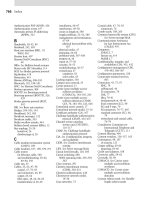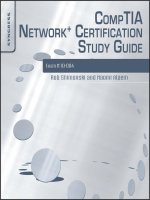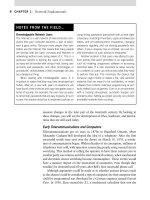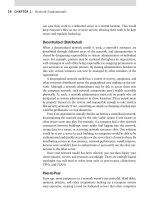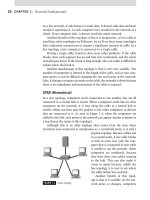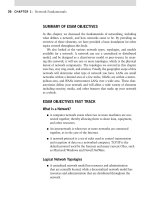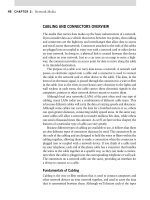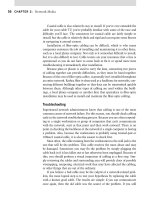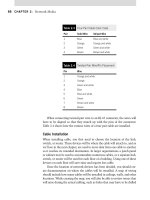CompTIA Network+ Certification Study Guide part 11 ppsx
Bạn đang xem bản rút gọn của tài liệu. Xem và tải ngay bản đầy đủ của tài liệu tại đây (71.18 KB, 10 trang )
CHAPTER 2: Network Media 86
IEEE1394 (FireWire)
If you’ve ever hooked up a digital camera, digital video (DV) camera, or other
devices that need to transfer large amounts of data to your computer, you
may have used FireWire. FireWire is a proprietary name for an external bus
that supports fast data transfer rates. Apple Computers originally developed
the technology, but it has since been standardized as IEEE1394. Since then,
other companies have developed their own trademark names, including
Sony’s iLink.
Devices that follow IEEE1394 allow data to be transferred at 400 Mbps
(in IEEE1394a) and 800 Mbps (in IEEE1394b). In addition to this, it allows
a single 1394 port to have up to 63 external devices connected to it. It is
similar to USB in that can provide power to a device and supports both plug
and play and hot plugging.
Wireless Media
As we discussed briefly in the previous chapter and will discuss in greater
detail in Chapter 4, wireless networks require minimal cabling. Data is
transmitted over the air using wireless adapters and wireless routers, so little
to no cabling is required for network communication.
Transceivers (Media Converters)
The term transceiver is short for transmitter-receiver, which also describes
its purpose on a network. Transceivers are the portion of a network interface
that transmits and receives electrical signals across the transmission media.
They are also the part of the interface that actually connects to the media.
Transceiver types can be classified as being either on-board, which are built
onto a network card, or external.
With an external transceiver, the actual media connection is made
external to the NIC using a small device that attaches via an extension cable
to the NIC. The types of transceivers and media that can be served by a NIC
determine the appropriate connector, and, as we saw earlier in this chapter,
each media type has a typical connector type or connection method. One
such connector is an AUI connector, which is also called a DIX connector.
This type of connector can be found on the back of many NICs. The AUI
connector enables a network card to be used with multiple types of media.
A common implementation is to use this configuration for an Ethernet
card that can be attached to twisted-pair, thickwire, or thinwire coax by just
changing the external transceiver type.
Summary of Exam Objectives 87
On networks that used 10Base2 and 10Base5 media, transceivers are
used to connect to the cable and communicate with the network. 10Base5
networks use a device called a MAU, which taps into the thick cable and
allows the workstation to connect to the network using an AUI cable. When
a MAU and AUI cable are used on a 10Base5 network, the onboard trans-
ceiver of the network card isn’t used. Instead, the transceiver in the MAU is
used, which acquires power through the AUI cable from the network adapter
card on the workstation. On 10Base2 networks, no more than 30 transceiv-
ers can be connected to any segment, while on 10Base5 networks no more
than 100 taps can be performed per segment.
Because the network adapter’s transceiver isn’t used, the MAU detects
collisions by sending out a signal called a heartbeat or signal quality error
(SQE) test signal. The MAU’s heartbeat is sent to the workstation when a
collision is detected, allowing it to deal with the collision accordingly, as we
discussed in the previous chapter when discussing bus topologies. When a
frame of data is successfully transmitted, the MAU will also send a heartbeat
to determine whether the bus is active.
An exception to performing this test is when a repeater is used on the net-
work, which resends data to other segments of the network. When a repeater
receives the heartbeat signal, it will identify it as a collision, and send a
jam signal. To prevent this, and thereby keep the network from becoming
bogged down with these signals, the MAU’s SQE test signal feature should
be turned off if a repeater is used.
SUMMARY OF EXAM OBJECTIVES
Cabling and connectors are essential to any network, providing a medium
that allows computers to communicate and send data across the network.
Cabling can be twisted-pair, coaxial, or fiber optic. Coaxial consists of a
single copper wire to carry data, twisted-pair uses pairs of copper wires
twisted together, and fiber-optic cabling sends data across the network in
the form of modulated pulses of light.
In using the various cables, there are a number of issues that may impact the
performance of a network. EMI can be caused by florescent lighting, machin-
ery, or other sources that put out a low voltage, low current, high- frequency
signal that can interfere electronic signals transmitted over cabling. Similar
to this is RFI, which is caused by electromagnetic radiation in the radio fre-
quency range. Putting cables too close to one another can cause another form
of interference called crosstalk, where the electromagnetic field of one wire
CHAPTER 2: Network Media 88
interferes with the transmission of another. Finally, data can weaken over
distances, causing a problem called attenuation. These issues must be dealt
with during the installation of network cable, or dealt with once cabling has
been installed.
When problems present themselves, electronic devices called cable tes-
ters may be used to find the cause or location of a problem on the cable.
Tools like tone generators, TDRs, wire map testers, and oscilloscopes can all
provide information that is useful in fixing a problem.
We also saw that data can travel along a cable in several ways, using a
simplex, half-duplex, or full duplex data transfer. When simplex is used, data
moves in a single direction. Half-duplex allows data to move in either direc-
tion, but in only one direction at a time. When full duplex is used, however,
data can move in either direction simultaneously.
We discussed that Ethernet is a standard that’s used on most networks
today. Ethernet has specifications for 10Base2, 10Base5, and 10BaseT
networks, and uses CSMA/CD, which prevents devices from interfering with
one another during transmission by detecting collisions of data. A newer
variation of Ethernet is Fast Ethernet, which supports transfer speeds of up
to 100 Mbps.
There is a wide variety of media standards, some of which have been
around since the early days of networking. 10Base2 and 10Base5 are net-
works that use coaxial cable to transfer data, while 10BaseT, 100BaseTX, and
1000BaseT use UTP cabling. Finally, we also discussed various standards
used for fiber-optic networks, including 10BaseFL, 100BaseFX, 100BaseSX,
1000BaseLX, and 1000BaseCX.
Connectors are used to terminate cables and provide a method of con-
necting the cable to the device. There are a number of connectors available,
including D, RJ, DIX, and BNC for coaxial and twisted-pair networks. SC,
ST, LC, and MTRJ connectors are used for fiber-optic cabling.
Just as there are various connectors, there are also a variety of media
types. Twisted-pair cable comes in a variety of grades, ranging from CAT1
to CAT7. UTP Category 3 or higher can be used for data communications,
but Category 5 or higher is recommended. The other form of twisted-pair
is STP, which has a shield that helps to prevent interference. Coaxial cable
also comes in more than one form. RG-58 cabling or Thinnet is thin coaxial
cable (about 1/4 inch thick) used on 10Base2 networks, while RG-59 cabling
or Thicknet is thick coaxial cable (about 1/2 inch thick) used on 10Base5
networks. Fiber-optic cabling can be SMF, which is designed to transmit a
single beam of light from a laser, while MMF is used to carry multiple beams
of light at the same time. Such variations show a wide variety of media types
to choose from when designing a network.
Exam Objectives Fast Track 89
EXAM OBJECTIVES FAST TRACK
Cabling and Connectors Overview
Cabling is the wire or fiber medium that is used to connect
computers and other network devices of your network together and
used to carry the data that is transmitted between them.
Coaxial cable, also referred to as coax, uses a single copper wire at
the center of the cable to carry signals. The wire is surrounded by
layers of insulation that protect the wire and its transmissions.
Twisted-pair cables consist of pairs of wires that are twisted to reduce
interference. This type of cabling may be unshielded or shielded.
Fiber-optic cable carries digital data signals in the form of modu-
lated pulses of light.
Media Issues
EMI is a low voltage, low current, high-frequency signal that can
interfere with the electronic signals transmitted over cabling. EMI
is also referred to as noise, as its signals come from outside sources
and can corrupt data sent over cabling.
RFI is caused by electromagnetic radiation in the radio frequency range.
Crosstalk occurs when the signal of one wire bleeds onto another
wire so that the electromagnetic field of one wire interferes with
data transmission on another.
Bandwidth is a measurement of the amount of data that can be
passed over a cable in a given amount of time.
Attenuation occurs when data transmitted over media weakens over
distance.
Cable Testers and Troubleshooting
Tone generators are used to perform tests on phone and network lines
by clipping to a wire, terminal panel, or standard modular jack and
will aid in the identification of wires during the wire-tracing process.
TDRs use signals that are sent down the cable to identify problems.
An electronic pulse travels down the cable until it is reflected back,
much like sonar.
CHAPTER 2: Network Media 90
Wire map testers are often used on twisted-pair cabled networks to
test for opens, shorts, or crossed pairs, and will provide information
that may indicate improper wiring.
Oscilloscopes can be used to determine when there are shorts,
crimps, or attenuation in the cable.
Simplex, Half-Duplex, Full-Duplex
Simplex refers to data moving in a single direction.
Half-duplex refers to data traveling both ways on the medium, but
in only one direction at a time.
Full-duplex refers to data traveling in both directions simultaneously.
Cabling
Ethernet is a standard for most networks used today, and includes
specifications for 10Base2, 10Base5, and 10BaseT.
CSMA/CD prevents devices from interfering with one another
during transmission by detecting collisions of data.
Fast Ethernet is a standard that provides speeds of 100 Mbps.
Cabling Management
Patch panels are primarily used for easy of use and flexibility, and gives
the network administrator the ability to move connections quickly.
There are multiple types of distribution facilities, the IDF
(intermediate) and MDF (or main).
Termination devices such as a 66 block or a 110 block are
commonly used to provide termination point and are generally
located in wiring closets in your facility.
A patch and impact tool is used to terminate copper cabling to
66 and 110 blocks.
For the Network exam you will need to know how to install
commonly used wiring distribution systems. Distribution systems
are nothing more than a term used to describe the hierarchical
system of cross connections that lead to a local PBX, central con-
centrator or the CO or elsewhere.
Exam Objectives Fast Track 91
Media Standards
10Base2 uses coaxial cabling to transmit data at speeds of 10 Mbps
across cable segments that are up to 185 m in length.
10Base5 uses coaxial cabling to transmit data at speeds of 10 Mbps
across cable segments that are up to 500 meters in length.
10BaseT uses UTP cabling to transmit data at speeds of 10 Mbps
across cable segments that are up to 100 m in length. The UTP
cabling must be Category 3 or higher.
100BaseTX uses UTP cabling to transmit data at speeds of
100 Mbps across cable segments that are up to 100 m in length.
The UTP must be Category 5 or higher.
10BaseFL uses fiber-optic cabling to transmit data at speeds
of 10 Mbps across cable segments that are up to 2 km in
length.
100BaseFX uses fiber-optic cabling to transmit data at speeds of
100 Mbps across cable segments that are up to 400 m in length
with half-duplex communication or 2 km for full-duplex.
1000BaseT uses UTP cabling to transmit data at speeds of
1000 Mbps across cable segments that are up to 100 m in length.
The UTP must be Category 5 or higher.
100BaseSX uses fiber-optic cabling to transmit data at speeds of
1000 Mbps across cable segments that are up to 550 m in length.
1000BaseLX uses fiber-optic cabling to transmit data at speeds of
1000 Mbps across cable segments that are up to 550 m (MMF) or
up to 10 km (SMF) in length.
1000BaseCX uses fiber-optic cabling to transmit data at speeds
of 1000 Mbps across cable segments that are up to 100 m in
length.
Connectors
D connectors are shaped like the letter D and have pins that
connect to a female D connector.
RJ connectors are used to connect devices used for voice and data
communications.
CHAPTER 2: Network Media 92
DIX stands for Digital Intel Xerox, who developed the connector for
use with an AUI that’s used with 10Base5 cable.
BNC connectors are used to terminate coaxial cabling and provide
connections to devices.
There are a number of connectors available for fiber-optic cabling,
including SC, ST, LC, and MTRJ.
Media Types
Twisted-pair cable comes in a variety of grades. UTP Category 3
or higher can be used for data communications, but Category 5 or
higher is recommended.
The difference between UTP and STP is that STP has a shield
designed to keep interference out by protecting the wires inside
from EMI caused by outside sources.
RG-58 cabling or Thinnet is thin coaxial cable (about 1/4 inch thick)
used on 10Base2 networks.
RG-59 cabling or Thicknet is thick coaxial cable (about 1/2 inch thick)
used on 10Base5 networks.
SMF is optical fiber that’s designed to transmit a single beam of
light from a laser. The beam of modulated light provides greater
bandwidth and allows cable to be run over longer distances.
MMF is used to carry multiple beams of light at the same time, using
a light-emitting diode (LED) as a light source. Each of the beams is at
a slightly different reflection angle within the core of the fiber.
Other Media
FireWire is a proprietary name for IEEE1394, which is an external
bus that supports fast data transfer rates of 400 Mbps (in IEEE
1394a) and 800 Mbps (in IEEE 1394b).
Wireless media is used to transmit data without cable.
Transceivers are the portion of a network interface that transmits
and receives electrical signals across the transmission media.
Transceivers may be onboard (on a network card) or external.
Self Test 93
EXAM OBJECTIVES FREQUENTLY ASKED QUESTIONS
None of the workstations on the network are able to communicate Q:
with each other. They use a thin wire coax Ethernet to connect to
each other. What may be causing the issue?
The backbone has been severed or improperly terminated. Find the A:
point at which the bus became severed and reconnect it, make sure
the backbone is properly terminated.
You have a brand new UTP cable, but the workstation is still not Q:
able to communicate on the network. The workstation worked
with your test cable. What may be causing the issue?
The brand new UTP cable may be a crossover cable. Obtain a regu-A:
lar UTP cable.
Is fiber the best networking media to implement in a standard of-Q:
fice environment?
Normally, due to cost limitations, offices are wired with UTP or STP A:
and the data center is wired with fiber. Fiber is also often used as a
backbone to connect one building to another. This is typically the
most cost-efficient manner of providing high-speed networking for
your servers and providing acceptable access speeds to your users.
SELF TEST
You are the network administrator of a 10BaseT network. On the 1.
weekend, when few people are working, you run 110 m of cable to
a new server that is being used as a file server. The cable is installed
in a new section of the building, where no cabling currently exists.
When you attempt to access files on the server, they are experienc-
ing errors and corrupt data. Which of the following is most likely
the cause of this problem?
A. Bandwidth
B. Attenuation
C. Crosstalk from a neighboring cable
D. CSMA/CD issues
Your company uses UTP cable for all of its network connections 2.
including workstations and servers. The users have reported
CHAPTER 2: Network Media 94
problems connecting to one of the most important servers on the
network and you have been called in to look at it, due to a possible
physical security breach by a former employee. While examining
the server, you find that a small battery-powered motor has been
placed and is running next to the server’s network connection.
What is causing the network problem?
A. Electromagnetic interference
B. Static electricity
C. Transceivers
D. Unknown, but the motor is probably unrelated
You are designing a new network and are concerned about interfer-3.
ence from other wires. Which of the following is most susceptible
to transmission errors due to crosstalk?
A. Coaxial
B. UTP
C. STP
D. Fiber optic
You are designing a new network for a grocery store. Cabling 4.
will have to run along the ceiling, where there are a significant
number of florescent lights. You are concerned about interference
from these lights. Which of the following cable types could be
used, which would not be susceptible to this type of interference?
A. Coaxial
B. UTP
C. STP
D. Fiber optic
Your network uses vampire taps and AUI connectors to access data 5.
from the network cable. Which of the following cabling types is
being used?
A. Thinnet
B. Thicknet
C. STP
D. Fiber optic
You are designing a 10Base2 network. In creating this network, what 6.
distance limitation will you be facing when installing the cabling?
Self Test 95
A. 100 m
B. 185 m
C. 500 m
D. 2 km
Examine the illustration shown in Figure 2.127. . Your network
is a 10Base2 network, and it uses these connectors to attach to
the network. Which of the following types of connectors is being
used?
A. RJ-11
B. DIX
C. BNC Barrel Connector
D. BNC T-Connector
You have been hired by a small company to cable its network. 8.
The company has offices in two buildings that are 300 m apart.
Both of the offices have about 15 computers and the numbers are
expected to grow in near future. All of the computers are within
90 m of one another. You need to decide on the cabling that will
be used both in the individual buildings, and which will be used to
connect the buildings LANs together. Which of the following will
you do?
A. Use UTP cabling in each of the buildings, and connect the two
buildings together using 10BaseT cabling.
B. Use fiber-optic cabling in each of the buildings, and connect the
two buildings together using 10Base2 cabling.
FIGURE 2.12
